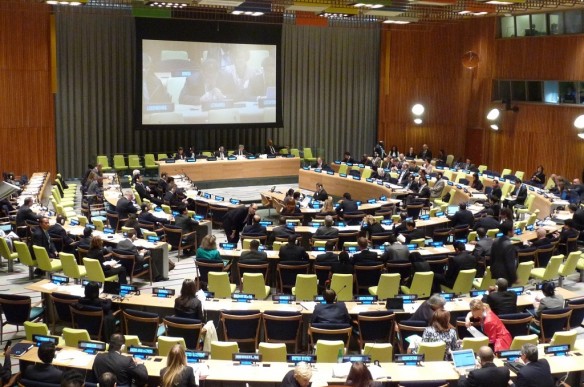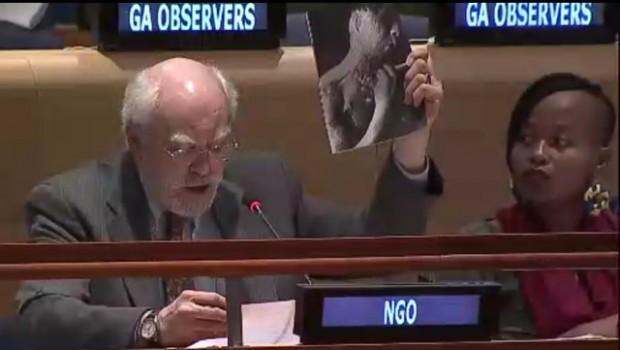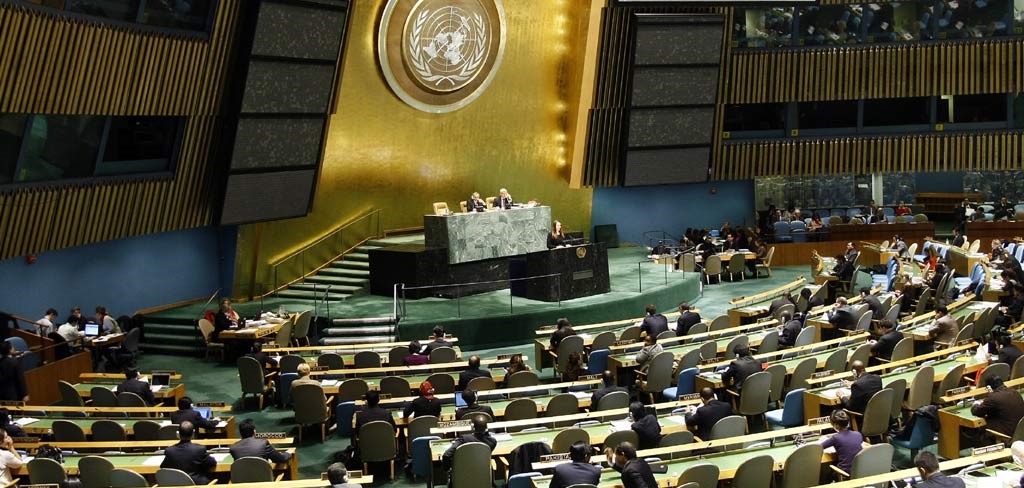On December 3, 2016, the UN General Assembly adopted ground-breaking Resolution 71/71, supported by over 140 countries, calling for the start of negotiations on an international treaty to prohibit and eliminate nuclear weapons, and affirming its decision to hold a High Level Conference on Nuclear Disarmament no later than 2018 to review progress.
The UN has previously held high level meetings on nuclear disarmament, but these were not much more than talk-shops. In contrast, the 2018 event will be the first time the UN General Assembly has held a high level conference on nuclear disarmament. Such an event carries with it the expectation of deliberations to reach an agreement or agreements on concrete nuclear disarmament measures.
The 2018 UN Conference, and its preparatory process, provide a unique opportunity for civil society and like-minded governments to elevate the issue of nuclear disarmament globally and build political pressure on the nuclear-reliant States to agree to specific nuclear disarmament proposals (see UNHLC Agenda below).
The conference could support, amplify and expand nuclear disarmament initiatives from other more limited forums such as bi-lateral negotiations, the Non-Proliferation Treaty Review Conference meetings and the Treaty on the Prohibition of Nuclear Weapons, which was adopted at the United Nations on July 7, 2017.

UN Summits and High Level Conferences
UN Summits and High Level Conferences are established by the UN General Assembly in order to elevate the political traction on key global issues. Such conferences garner the attention of media, activate government agencies, and provide opportunities for parliaments and public to challenge government policies and promote concrete goals. As such, UN High Level Conferences have had considerable success in recent years on difficult global issues, such as sustainable development, climate change and refugees.
The 2015 UN Sustainable Development Summit, which was held as a High Level Plenary meeting of the UN General Assembly, achieved agreement on 17 Sustainable Development Goals and commitments by governments to achieving these.
The 2015 UN Climate Change Conference, achieved the Paris Agreement, which establishes a commitment to keep global temperature rise under 1.5º C, and which includes all the major carbon emitting countries and most of the minor carbon-emitting countries.
The 2016 UN Summit on Refugees and Migrants achieved the New York Declaration which establishes global cooperation to address the causes of the refugee crisis and respond to the humanitarian needs of refugees. This has assisted incredibly in management of the refugee crisis in Europe and around the world.
Effective civil society action: UNFOLD ZERO consultations
In all three issues mentioned above, competitive national interests that were detrimental to the common good were overcome through effective cooperation and campaigning by civil society.
In order to ensure that the 2018 UN High Level Conference on Nuclear Disarmament (UNHLC) has similar success, we need to build effective cooperation and campaigning from the range of civil society networks that are engaged in nuclear risk-reduction, non-proliferation and disarmament.
UNFOLD ZERO and PNND held a number of private consultation meetings with governments, as well as open consultation meetings with non-governmental organisations in Geneva, London, New York, Vienna, Washington and other locations in early 2017. At these meetings we discussed strategy and campaign activities to build success for the UNHLC.

Facilitating cooperation: the beauty of the UNHLC
Cooperation between the nuclear arms control and disarmament/abolition communities and networks will be vital to ensure success of the UNHLC.
Traditionally there have been campaign and strategy differences between such networks. Some networks focus primarily on non-proliferation. Others focus on risk-reduction and incremental disarmament measures that can be taken by nuclear-reliant States (the nuclear-armed States and their allies). And others focus on comprehensive prohibition measures, such as nuclear-weapon-free zones or a global nuclear ban treaty.
The beauty of the UNHLC is that it can include promotion of all strands (non-proliferation, risk-reduction, incremental measures and stronger prohibition measures). These can be advanced as complementary measures that are not in competition with each other. This gives an opening for the arms control and abolitionist networks to work together for a successful conference.
UNHLC Agenda – what could be achieved?
The agenda of the UNHLC has not yet been set. The United Nations General Assembly has still to decide the dates for the preparatory meeting at which the UNHLC agenda will be decided. This leaves an opening for civil society to influence the agenda, and therefore what could be achieved by the conference.
It will be important to set an agenda that is significant in terms of impact on nuclear weapons policies, but also realistic. Of course, both of these aspects will be influenced by how well civil society networks campaign to elevate the UNHLC in governments, parliaments, media, public consciousness etc… This reinforces the need for civil society to start strategising, cooperating and campaigning soon.
Civil society and like-minded governments could, for example, push for the following for the conference;
- A forum for non-nuclear States (and maybe others) to announce their ratification of the nuclear prohibition treaty;
- Adoption of a declaration by the nuclear armed and allied States affirming that their sole purpose for nuclear weapons is to deter other nuclear weapons and that they would never use nuclear weapons first;
- Decide to request the UN to convene a conference for the establishment of a Middle East Zone free from nuclear weapons and other WMD (rather than waiting for the 2010 NPT review conference to do this);
- Adopt a framework agreement (or political declaration), endorsed by the nuclear-armed States, on a phased program to reduce nuclear stockpiles, prohibit any use of nuclear weapons and setting other achievable benchmarks for the complete elimination of nuclear weapons.
Consensus or voting
Multilateral agreements can be adopted either by consensus or by majority vote of those participating in the international conference.
The Conference on Disarmament is required to operate by consensus. Although it has succeeded in negotiating a number of agreements including the Chemical Weapons Convention and the Comprehensive Nuclear Test Ban Treaty, the consensus rule has resulted in no disarmament agreements being adopted in the past 20 years.
The NPT Review Conferences generally work by consensus. Sometimes they are able to reach agreement on key decisions and final documents – such as in 1995, 2000 and 2010, but other times they are unable to do so. In addition, the consensus practice can be used by nuclear-armed States to ‘water-down’ the nuclear disarmament proposals resulting in rather weak agreements.
The 2017 UN conference to negotiate a nuclear prohibition operated by UN General Assembly rules, which allowed for a vote on the negotiated treaty. This ensured that no country could block the adoption of the treaty. However, it also meant that the treaty was adopted without support of any nuclear-armed and allied states.
The 2018 UNHLC will also operate on UN General Assembly rules, but could adopt a mixed approach with some decisions adopted by consensus and others by a vote.
Other processes – ban treaty, NPT, NPR….
There are a number of important nuclear risk-reduction, non-proliferation and disarmament processes in 2017. These include, inter alia, the resumption of the NPT Review Cycle (with the first preparatory meeting in Vienna for the 2020 NPT Review Conference), ratifications of the nuclear prohibition treaty, and the United States Nuclear Posture Review (NPR).
The NPR could take up to two years from President Trump’s inauguration to complete (President Obama took just over two years to complete his NPR). The NPT Review Cycle will not reach any decisions until 2020. The UNHLC can influence and complement these and other nuclear disarmament processes.
The nuclear-armed States (and some arms control groups) discount, and attempt to discredit, comprehensive prohibition initiatives (such as the ban treaty) as diversions from the real business of step-by-step measures for nuclear disarmament. Similarly, some non-nuclear countries (and some abolitionist organisations) discount and attempt to discredit incremental measures by the nuclear-armed States and their allies, arguing that they are diversions from the ‘real’ measure for nuclear disarmament which is an immediate and comprehensive ban.
In order to ensure success of the UNHLC, we must avoid these extreme positions, and the notion that work in one area or forum is a diversion from work in other areas or forums. Indeed, preparation for the UNHLC can proceed alongside the NPT prep conference, ban treaty negotiations, US nuclear posture review and other initiatives – and can incorporate and build upon these in the 2018 conference.
Click here to download a longer PDF version of this article
UNFOLD ZERO working paper to the 2017 NPT prep com on the 2018 UN High Level Conference nike

